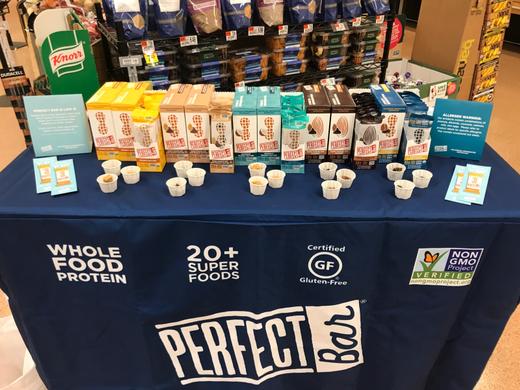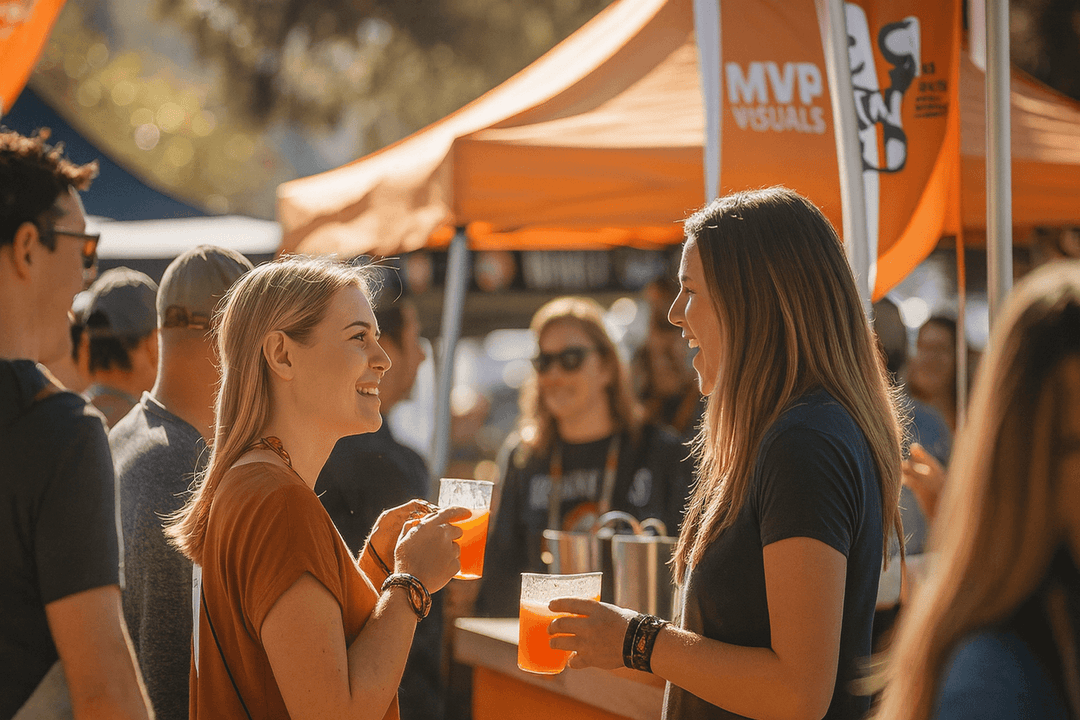For your business to stand out and get noticed at trade shows, expos, conferences, and marketing events, you need custom-branded tablecloths.
Branded tablecloths are unparalleled in creating brand awareness, engaging with your target market, and attracting new clients.
Getting the right tablecloth for your brand seems like a no-brainer. However, with a variety of designs tailored to serve different customers’ needs, the task requires a little research and forethought.
Having been in the business since 2006, we at MVP Visuals have know the details on how to help you get the most out of your branded tablecloth.
Today, we’ll share our cheat sheet to help you:
- Radiate a professional image to your potential customers
- Achieve an amazing level of detail with sharp vibrant prints
- Buy a tablecloth that you can reuse in many events
We’ll also share information on how to get the best promotional tablecloth while on a limited budget.
Do: Consider the Best Style For Your Event

When buying a branded tablecloth for an event, there are two style features that affect the usability of your tablecloth:
- Fit: Branded tablecloths are available in either throw-style or fitted options. Throw-style polyester tablecloths drape loosely over the table, while their fitted counterparts have inverted pleats and a boxy fit. Spandex tablecloths are only available in the fitted style, where they fit around your table like a glove.
- Back paneling: You get to choose between open and closed-back styles for spandex and polyester tablecloths. Open back paneling is best when you need to access merchandise under the table or some space to put your legs when seated on the other side. Whereas closed-backs are convenient if you want to delight your customers with a 360-degree view of your branding. However, stretch and stiff canvas fabrics can be customized with a zipper on the closed back to give an easier on-and-off experience.
Here, your choice must be guided by the kind of event you’re attending, your budget, and your personal preferences.
Don't: Compromise on Fabric Quality

When it comes to fabric, there’s much to choose from. Therefore, you have to ensure that you get the right fabric for your specific needs.
Offerings may vary between vendors, but our custom printed tablecloths come in three main fabrics:
- Polyester: A 300 denier weight fabric with wrinkle-resistant and flame-retardant properties
- Spandex/Stretch: 180–240 g weight fabrics known for their elasticity
- Canvas: A 600 denier weight fabric with flame, liquid, and UV-fade resistant properties
Each type of fabric is suitable for various customer needs.
For example, canvas is liquid-resistant and therefore perfect as an outdoor table cover where spillages are likely—it’s also good for any kind of weather.
Polyester and spandex are more popular when it comes to branded tablecloths for events. The table below shows the benefits of each.
|
Easy to clean stains off and can be machine dried |
Can be cleaned but not machine dried since heat can damage it |
|
Can be ironed to get rid of creases |
Does not crease, so there’s no need for ironing |
|
Elegant for indoor trade events, expos, and outdoor events |
Suitable for indoor and outdoor corporate events |
Getting a high-quality fabric for any event, indoor or outdoor, reflects your brand as serious and professional. Therefore, do not compromise on quality.
Always choose a fabric that’s suitable for the event depending on the design that you need for the event.
Do: Optimize Your Design
The shape, size, and color are essential parts of getting the perfect table cover for trade shows. They all determine the impact of the branding on potential leads.
Although rectangular-shaped tables are the most popular, don’t limit yourself. You can also opt for a round table or even a cocktail table. These can make you stand out and encourage more engagement for you with your leads.

For the tablecloth to fit perfectly, ensure you get the correct measurements. If you’re not sure of the table measurements, we suggest you get a convertible tablecloth throw that’s adjustable from 6 ft to 8 ft long.
How you blend in the colors determines your brand’s visibility and memorability.
You color scheme has to:
- Be consistent with your brand colors: If your design doesn’t match your brand, it can create a jarring image that doesn’t complement your brand colors.
- Evoke emotions: Use colors to express brand personality. For instance, red evokes emotions of boldness and blue evokes emotions of dependability.
- Stand out among competitors: Do not blend into the theme where you have competitors. Use colors to help your brand stand out.
- Contrast to make your logo pop: Base colors must create contrast with the logo design for it to be visible.
Try to come up with a simple yet effective design. When it seems like there’s a lot going on in a design, it’s hard to follow or remember subconsciously.
Work closely with your design team to create something unique and aligns with your goals for the event.
Don't: Overlook the Printing Method

Once you’ve chosen the perfect design, fabric, and color, ensure the printing method used to brand the tablecloth brings out a sharp and crisp image.
There are three methods of imprinting logos on tablecloths:
- Thermal transfer: Also known as heat transfer paper. The image/logo is printed on special paper. Afterward, the paper is laid onto the fabric, and heat is applied to transfer the image to the fabric.
- Dye sublimation: Also known as digital heat transfer. The graphics are digitally printed and then heated to transfer the image to the tablecloth.
- Screen printing: The design is made by printing ink on the fabric through a screen bearing the desired graphics.
The table below shows a feature comparison of the three types of imprinting methods.
|
Dye Sublimation |
Screen Printing |
Thermal Transfer |
|
Allows for limitless color designs |
Suitable for one color options |
Poor printing color control |
|
Sharp and crisp high definition images |
May have unaligned graphics if the screen was poorly set up |
Looks good at first then fades very fast when washed |
|
Most common method on the market, reasonable cost |
Older method and usually only cost-effective for high volume orders |
Least expensive, but incomparable to long term quality |
|
Works best on a light colored polyester fabric |
Suitable for any type of fabric |
Allows printing on darker cotton fabrics as well as polyester |
Due to the unmatched quality of the crisp and vivid images, we recommend dye sublimation.
Dye sublimation may be a little costlier than the other methods but the high-quality graphics it produces pop and help your brand attract more attention.
Do: Ensure Color Consistency and Accuracy in Branding

Imagine taking your time to create a beautiful logo or graphic to be printed on a tablecloth, only for the end product to be inconsistent with what you envisioned.
Every computer monitor is different, and every printer is different. Colors can therefore look and print differently depending on the monitor, printing machine, or even the person printing.
Ensuring color consistency in all of your branding shows professionalism and attention to detail. It also helps create a standard look for your brand.
Some vendors use CMYK 4 color process to print the intended colors on the substrate—in this case, the tablecloth fabric. CMYK stands for cyan, magenta, yellow, and black (K stands for key color which is black).
In the CMYK process, tiny overlapping dots are layered together in a combination of these four colors. The amount of color is subtracted in different percentages to create the same color on the digital print.
The problem with this method is the level of accuracy in the final colors. Colors printed from the same document by different printers using the CMYK system show a tonal difference.
There’s limited color choice, and if your colors are out of the printer’s scope, you’re going to receive a tablecloth with dull colors.
Shade variation is unavoidable when using the CMYK method.
For a high-quality, colorful, and consistent method we suggest you use the Pantone Matching System (PMS).
In the Pantone Matching System, each color is linked to a different sample and number. This allows an exact final match even when you’re producing tablecloth graphics from different printers.
At MVP Visuals, our team will work with you to get the correct Pantone within your brand and logo to bring out the exact replica of your brand colors.
Stand Out And Get Your Business Noticed
At MVP Visuals, we specialize in helping brands increase their ROI with vibrant custom displays. We’re committed to understanding your brand’s needs and will work closely with you to develop exactly what you have in mind.
To show our commitment, we give you the opportunity to request a sample before you place an order! We have stock samples to showcase various color choices, or if you'd like, you can also request a custom printed sample with your logo and brand colors.
Does that sound good to you? Give us a call at (800) 980-6871 to speak with a member of our service team, use the Live Chat, or send us an email at hello@mvpvisuals.com. You always reach a real person during business hours.



